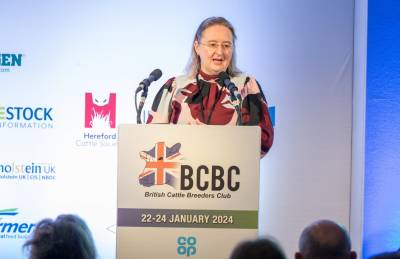
To meet the UK’s legislative goals for net zero, as measured using the UK National Inventory, the farming industry needs to urgently move with a great pace on measuring, monitoring, and reducing gross farm emissions, warned a leading agricultural professor.
Speaking at the British Cattle Breeder’s Conference on 24 January, Professor Elizabeth Magowan, Director of Sustainable Agri-Food Sciences Division in the Agri-Food and Biosciences Institute, Northern Ireland, said agriculture needs to focus on reducing both gross emissions to meet UK National Inventory and the carbon footprint of farming systems.
UK National Inventory counts on-farm gross emissions from livestock, fertiliser and carbon sequestration in land and forestry. Gross emissions are the total amount of methane and nitrous oxide produced.
This is different to farm carbon footprints which encompass end-to-end emissions from meat and milk outside the farmgate, she said. Carbon calculators tend to focus on emissions intensity i.e. CO2e/kg of milk or meat.
Currently, NI produces 28% of total GHG emissions compared to other sectors, but the Climate Change Committee’s (CCC) balance pathway, predicts that although emissions from agriculture will be much lower than they are currently, they will represent 75% of total emissions by 2050 because other sectors are expected to have completely decarbonised by that stage.
“While material improvements have been made in the past 30 years, the magnitude of change expected in the next 30 years [to meet targets] is stark. We can’t underestimate the challenge. We really need to get our heads around the amount of transformational change that the agricultural sector needs to make,” said Prof Magowan.
She said agriculture could meet 2030 targets using the tools already available such as genetics and feed additives.
She highlighted two different models – one spring calving and one high-yielding, indoor dairy herd – where emissions could be cut by 30% and 17%, respectively, by adopting interventions to mitigate emissions and planting trees on land freed up because of increased farm efficiency, therefore retaining farm output.
These included: sowing legumes in grassland, releasing land for forestry, using methane inhibitors and protected urea, as well as reducing age at first calving while holding milk output.
Carbon sequestration
Prof Magowan said farmers needed to temper their expectations around carbon sequestration because debate was still ongoing as to whether an increase in carbon stores should be claimed as sequestration.
This is because carbon stocks in grassland can be built by applying manures and improving organic matter. This prevents carbon being released into the atmosphere when these materials are stored, but it is not the same as drawing carbon from the atmosphere and locking it into soils, she explained.
Currently, there is a huge gap in scientific knowledge regarding soil carbon sequestration under grassland.
“There’s lots of tools we can adopt right now, and we need to get on with adopting them. We all must start monitoring, measuring, and reporting in greater detail and, in the meantime, we need to adapt to the changing climate we work with.”